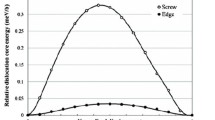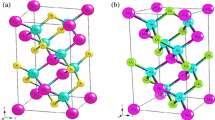Abstract
The success of molecular orbital theory in calculating crystal properties such as bond lengths and atomic force constants has been well documented in the literature. Calculations can be extended to crystals under simulated compression and strain to determine elastic moduli and their pressure derivatives. Comparison of the molecular orbital results with both experimental values and results obtained by calculations such as the potential induced breathing model provides insight into the nature of chemical bonding in MgO. In this study, several molecular clusters were investigated as possible models for MgO; the cluster Mg4O4H24 was chosen as the best model. Molecular energies were calculated with respect to bond length for both compression and expansion based on clusters that had been optimized for minimum energy. The resulting energy-volume curve was fitted to a recently derived equation of state (Brown, in preparation) to derive the values of K 0 and dK0/dP and the individual elastic moduli and their pressure derivatives were calculated by applying strain to the molecular cluster at both zero and elevated pressures. Agreement between theory and experiment varies between parameters, but the overall trend is encouraging. Since the molecular orbital model includes only short range interactions, its ability to approximating model the elastic moduli of MgO suggests a strong contribution to the elastic energy from short range interactions.
Similar content being viewed by others
References
Anderson OL, Liebermann RC (1970) Equations for the elastic constants and their pressure derivatives for three cubic lattices and some geophysical applications. Phys Earth Planet Inter 3:61–85
Binkley JS, Whiteside RA, Krishman R, Seeger R, DeFrees D, Schlegel HB, Topiol S, Kahn LR, Pople JA (1980) Gaussian 80 — An ab initio molecular orbital program, Department of Chemistry, Carnegie-Mellon University, Pittsburgh PA
Bukowinski MST (1985) First principles equation of state of MgO and CaO. Geophys Res Lett 12:536–539
Causa M, Dovesi R, Pisani C, Roetti C (1986) Electronic structure and stability of different crystal phases of magnesium oxide. Phys Rev B 33:1308–1316
Chang KJ, Cohen ML (1984) High-pressure behaviour of MgO: Structural and electronic properties. Phys Rev B 30:4774–4781
Geisinger KL, Gibbs GV, Navrotsky A (1985) A molecular orbital study of bond length and angle variations in framework structures. Phys Chem Minerals 11:266–283
Gibbs GV (1982) Molecules as models for bonding in silicates. Am Mineral 67:421–450
Gordon RG, Kim YS (1972) A theory for the forces between closed shell atoms and molecules. J Chem Phys 56:3122–3133
Hehre WJ, Stewart RF, Pople JA (1969) Self-consistent molecularorbital methods. I. Use of Gaussian expansions of Slater-type atomic orbitals. J Chem Phys 51:2657–2664
Hehre WJ, Ditchfield R, Stewart RF, Pople JA (1970) Self-consistent molecular-orbital methods. IV. Use of Gaussian expansions of Slater-type orbitals. Extension to second row molecules. J Chem Phys 52:2769–2773
Jackson I, Niesler H (1982) The elasticity of periclase to 3 GPa and some geophysical implications. In: Akimoto S, Manghnani MH (eds) High-Pressure Research in Geophysics, Adv Earth Planet Sci 12:93–113
Mao HK, Bell PM (1979) Equations of state of MgO and ɛFe under static pressure conditions. J Geophys Res 84:4533–4536
Mehl MJ, Hemley RJ, Boyer LL (1986) Potential-induced breathing model for the elastic moduli and high-pressure behaviour of the cubic alkaline-earth oxides. Phys Rev B 33:8685–8696
Mehl MJ, Cohen RE, Krakauer H (1988) Linearized Augmented Plane Wave Electronic Structure Calculations for MgO and CaO. J Geophys Res 93:8009–8022
Murnaghan FD (1944) The compressibility of media under extreme pressures. Proc Natl Acad Sci 30:244–247
Newton MD, Gibbs GV (1980) Ab initio calculated geometries and charge distributions for H4SiO4 and H6Si2O7 compared with experimental values for silicates and siloxanes. Phys Chem Minerals 6:221–246
Newton MD, O'Keefe M, Gibbs GV (1980) Ab initio calculation of interatomic force constants in H6Si2O7 and the bulk modulus of α-quartz and α-cristobalite. Phys Chem Minerals 6:305–312
O'Keefe M, Gibbs GV (1984) Defects in amorphous silica; ab initio MO calculations. J Chem Phys 81:876–879
Perez-Albuerne EA, Drickamer HG (1965) Effect of high pressures on the compressibilities of seven crystals having the NaCl or CsCl structure. J Chem Phys 43:1381–1387
Shannon RD, Prewitt CT (1969) Effective ionic radii in oxides and fluorides. Acta Crystallogr B 25:925–946
Suzuki I (1975) Thermal expansion of periclase and olivine and their anharmonic properties. J Phys Earth 23:145–159
Wolf GH, Bukowinski M (1988) Variational stabilization of the ionic charge densities in the electron-gas theory of crystals: Applications to MgO and CaO. Phys Chem Minerals 15:209–220
Author information
Authors and Affiliations
Rights and permissions
About this article
Cite this article
McCammon, C.A., Brown, T.H. & Meagher, E.P. Calculation of the equation of state and elastic moduli of MgO using molecular orbital theory. Phys Chem Minerals 17, 622–628 (1991). https://doi.org/10.1007/BF00203842
Received:
Issue Date:
DOI: https://doi.org/10.1007/BF00203842




